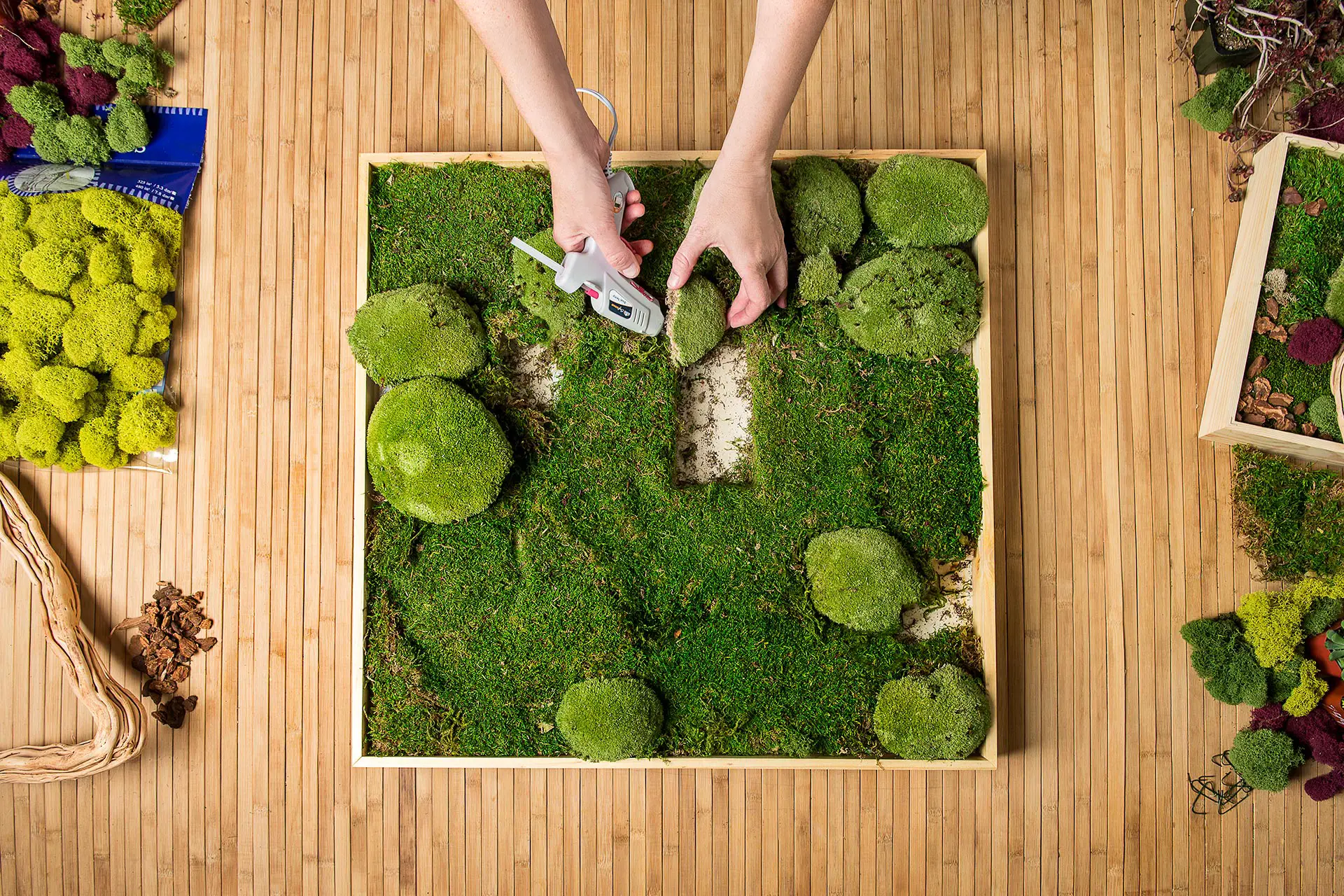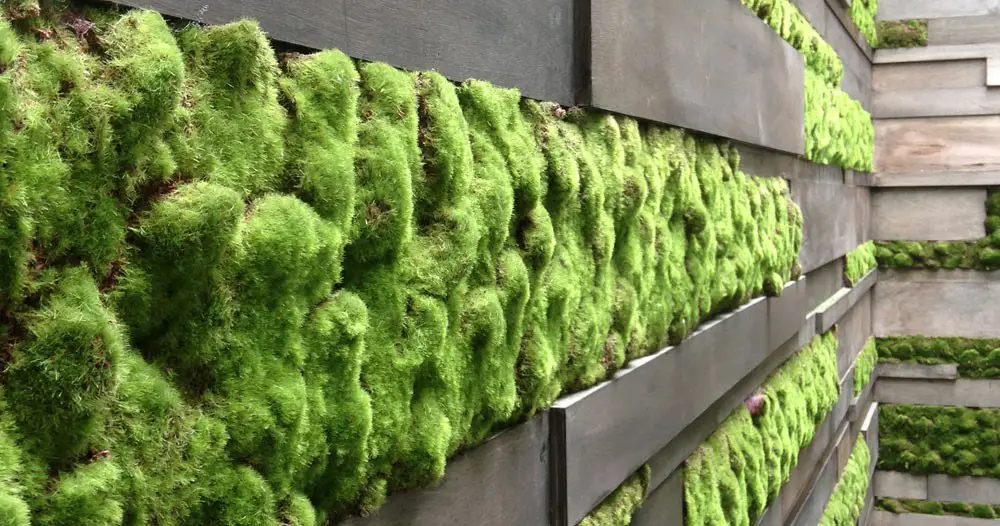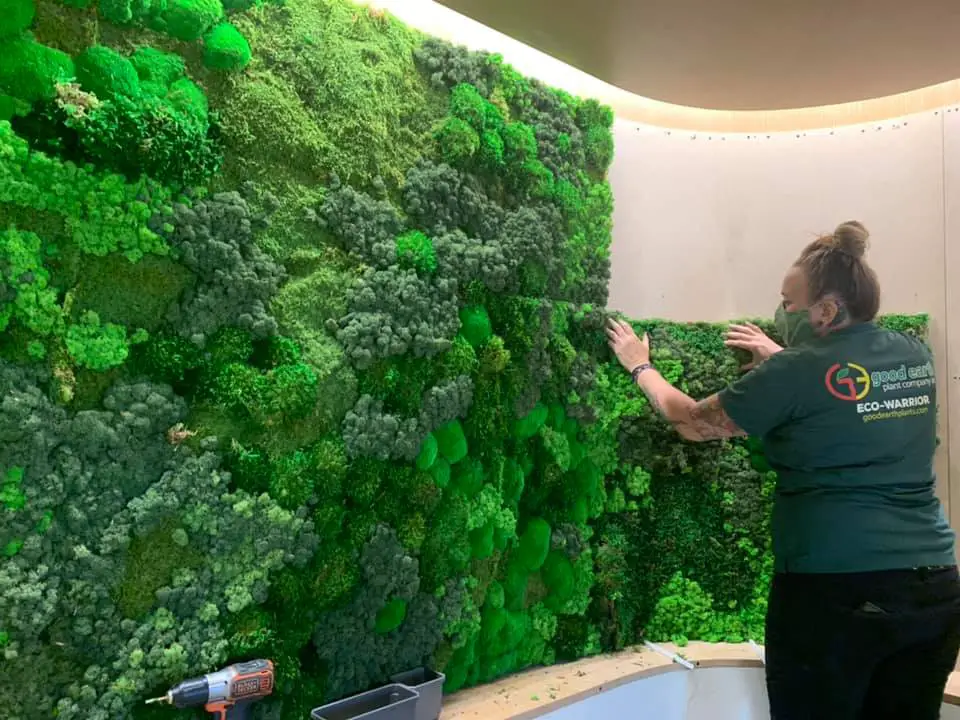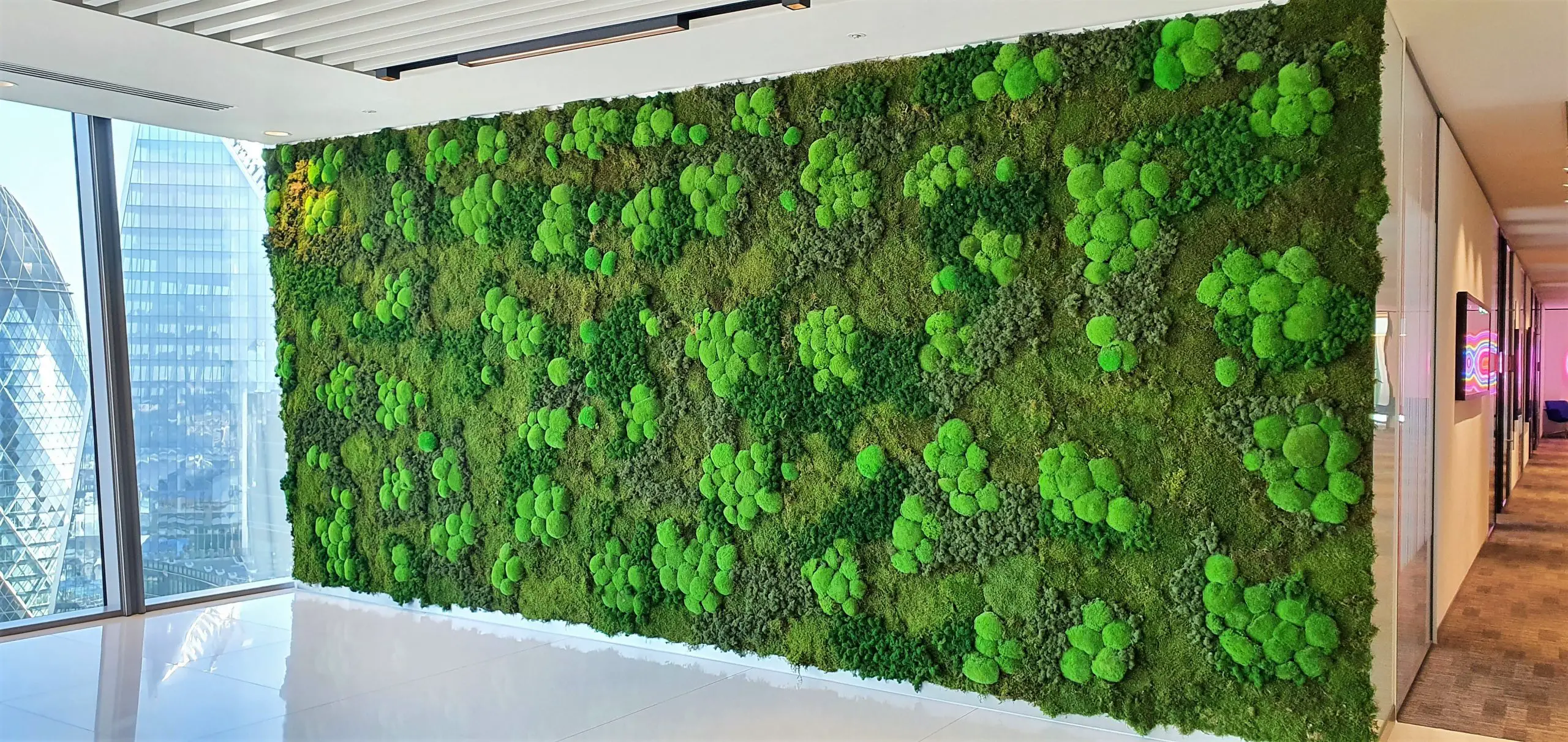Moss walls are not only a unique and beautiful way to bring nature into your home or garden, but they also offer a myriad of benefits that go beyond aesthetics. These captivating living decorations not only create an eye-catching and one-of-a-kind piece of art in your space but also contribute to improved air quality. The carefully arranged and curated species of moss on a wall or panel not only add a touch of lush greenery but also act as natural air purifiers, filtering out toxins and releasing fresh oxygen into the environment. Moreover, moss walls require minimal maintenance and are known for their ability to retain moisture, creating a microclimate that promotes plant growth and helps to regulate humidity levels in the surrounding area. So, by incorporating a moss wall garden, you not only enhance the visual appeal of your space but also create a healthier and more vibrant environment that connects you with the soothing beauty of nature.
How to make a living moss wall?
Making a living wall of moss is surprisingly easy and requires minimal effort. The first step is to choose the type of material you want to use as your base. Plywood, wood planks, or old picture frames all make excellent backing materials for creating your wall. Once you have chosen your material, it’s time to prepare the area where you will be installing your wall. Make sure to wipe down the surface with a damp cloth and allow it to dry completely before applying any moss.

The next step is to cut or tear pieces of sheet moss into small sections that will fit onto your chosen backing material. You can then place these pieces of moss on the board in whatever pattern you choose, leaving a small gap between each piece. Once completed, you will need to mist the wall with water and then secure it in place with adhesive such as a hot glue gun or spray adhesive. The wall should be left for several days to allow the moss to start settling and growing before adding any additional decorations or accents.
Finally, you’ll need to regularly mist the wall with water and ensure it gets plenty of indirect sunlight and a steady supply of fresh air. This will help the moss thrive and ensure that your living wall remains lush and vibrant for years to come. With these simple steps, you’ll have a beautiful living moss wall garden in no time!
Apart from creating living walls, moss can also be used to create other interesting craft projects such as terrariums and plant hangers. The possibilities are truly endless when it comes to using moss to enhance the beauty of your home or garden. Whether you’re looking to create a statement piece with a living wall, add some greenery with a terrarium, or simply add some natural flair with a simple plant hanger.[2]
Things to know before building a living moss wall
Before embarking on your moss wall project, it is essential that you familiarize yourself with the specific needs of the different types of moss. Each type has its own unique requirements when it comes to light, moisture and temperature levels. It is also important to note that sunlight is essential for keeping a living wall thriving. Moss walls should be placed in an area where they will get indirect sunlight for a few hours each day.
Additionally, moss walls require regular maintenance and should be misted with water every couple of days or so. You will also need to keep an eye out for any signs of decay or damage due to mold or insects as these can quickly spread throughout the wall. If you do find any signs of mold or insects, it is best to take action quickly as this can cause irreparable damage.[2]
Make a DIY Moss Wall – Building (or buying) the frame
If you want to create your own moss wall garden, the first step will be to build or buy a frame. Frames are typically constructed from wood and can range in size from small picture frames to larger backdrops that can span an entire wall. Once you have decided on the size of your frame, it is important to ensure that all edges and corners are sanded down to prevent injury or damage when handling the frame.
Next, you will need to attach a sheet of plastic mesh or chicken wire to each side of the frame. This will act as a support structure for the moss and help keep it in place. It is also important to make sure that all fasteners are securely attached so that they do not come loose over time. Once the frame has been constructed, it is ready to be filled with moss![2]
Outdoor moss wall garden

In addition to creating an indoor living wall, moss can also be used outdoors to create a stunning and unique feature in any garden. If you plan on building an outdoor wall, it is important to select the right type of moss for your climate. Many species of moss are hardy and can survive in colder climates, but there are some that require more warmth or moisture. Once you have chosen the right plant, you will need to make sure that it is placed in an area that gets plenty of indirect sunlight and has a steady supply of fresh air circulation.
Materials to include in a living moss wall project
In addition to moss, other materials can be included in your living wall project to add texture, color and interest. Some popular items include various types of accents such as gemstones or crystals, along with pieces of driftwood or decorative sculptures for added visual appeal. Other essential materials needed for a successful moss wall garden include water-soluble fertilizer that is specifically designed for moss, string or wire for securing pieces of moss in place, and a spray bottle for misting the wall with water.
By combining these elements, you can create a truly unique and eye-catching feature that will transform any indoor or outdoor space. With some creativity and attention to detail, your living moss wall garden can become an oasis of tranquility and beauty![1]
Plants for living moss walls
There are many different types of moss that can be used in living wall projects. Some popular varieties include sheet moss, reindeer moss, and hair cap moss. Sheet moss is a classic choice for creating lush and vibrant walls as it is easy to work with and requires minimal maintenance. Reindeer and hair cap mosses are great options if you are looking for something with more texture and color.
No matter which type of moss you choose, it is important to remember that each variety has its own unique needs when it comes to light, moisture, and temperature. Before purchasing any moss for your living wall project, make sure to read all labels carefully so that you can ensure optimal care for your plants![1]
Testing plants is part of the fun
Creating a living wall garden is an exciting and rewarding project that can add texture, color, and interest to any home or garden. While the process may seem daunting at first, it can be made easier by taking the time to familiarize yourself with the needs of different types of moss before getting started. By keeping these requirements in mind and doing regular maintenance checks for signs of decay or damage, you can ensure that your living wall will remain vibrant and lush for years to come!

Testing out different types of moss is part of the fun when creating a living wall garden. Experimenting with different species and varieties can lead to some stunning results. For those who are feeling extra adventurous, combining different colors and textures can create an absolutely breathtaking living wall that will transform any space into a serene and beautiful oasis.[1]
Decide on the types of moss to grow
The next step in creating a living wall garden is deciding which types of moss you would like to include. While sheet moss is often the go-to choice for many, don’t be afraid to mix and match different varieties for interesting results. Reindeer and hair cap mosses are great choices if you are looking for something with more texture or color. When choosing, it is important to remember that each type of moss has its own unique needs when it comes to light, moisture, and temperature.
Once you have decided on the types of moss for your wall garden, it’s time to get shopping! Make sure to purchase high-quality plants from a reputable dealer that specializes in mosses. This will ensure that you are getting healthy plants with strong root systems that will thrive in your living wall garden. With careful planning and regular maintenance, you can ensure that your living wall will remain vibrant and lush for years to come![4]
Moss selection and growth tips
When selecting the right moss for your living wall garden, it is important to consider the size of the pieces that you need. This will help ensure that you purchase enough material to adequately cover the frame. It is also important to take into account the type of environment where your moss will be placed as some varieties may require more warmth or moisture than others.
When preparing the moss for your living wall project, it is important to remember that moss will shrink over time. To allow for shrinkage, you should add more material than what is needed to initially fill the frame. This way, you don’t have to worry about having gaps in the wall later on.[4]
Assembling the pieces

Once you have all of the pieces, it’s time to start putting it all together. Start by arranging the moss on a flat surface in order to get an idea of how everything will fit into the frame. To ensure that your wall garden will stay lush and vibrant for years to come, make sure that each piece is securely fastened with string or wire.
Once the moss is in place, it’s time to start misting! Make sure to water regularly and check for signs of decay or infestation. With some regular maintenance and minimal effort, your outdoor living wall garden will become a stunning oasis that will transform any space into an inviting retreat.[4]
Hanging the frame
When it comes to hanging your frame, there are several options available. If you plan to hang the frame outdoors, make sure that you use metal fasteners such as screws or bolts that can withstand the elements. For those looking to hang their frame indoors, adhesive strips or Command Hooks may be used as an easy and effective way of ensuring that the moss wall stays securely in place.[3]
Indoor Moss Wall Vs. Outdoor Moss Wall
When deciding where to place your moss wall, you should take into account the environment that it will be in. While both indoor and outdoor moss walls can look stunning with proper care, each type has different requirements when it comes to light, moisture, and temperature.

For outdoor moss walls, make sure to choose a location that gets plenty of natural light but is not overly exposed to the elements. It is also important to check regularly for signs of decay or infestation due to increased moisture and temperature changes in outdoor environments.
For indoor moss walls, make sure that the location gets plenty of indirect sunlight but is not too warm or damp as this can lead to mold growth. Additionally, it is important to keep an eye out for signs of decay or infestation that can result from high humidity levels in indoor environments.
By taking the time to familiarize yourself with the needs of different types of moss and doing regular maintenance checks, you can ensure that your living wall will remain vibrant and lush for years to come![3]
FAQ
How long do moss walls last?
Moss walls can last for several years with proper care and maintenance. Regular misting, adequate light, and regular checks for signs of decay or infestation are essential to ensuring that your living wall remains lush and vibrant for years to come.
How do you get moss to stick to walls?

Moss can be secured to walls using a variety of methods such as screws, bolts, adhesive strips, or Command Hooks. When fastening the moss to the wall, make sure that it is securely fastened in order to ensure that it stays put.
Is a moss wall a good idea?
Moss walls are a great way to add some life and texture to any space. Not only do they look stunning, but they also act as natural air filters that can help improve the quality of the air around them. Additionally, moss walls require minimal maintenance and are relatively easy to install, making them an ideal choice for those looking to bring some green into their home or workspace.
What are the disadvantages of a moss wall?
The main disadvantage of moss walls is that they need to be placed in areas with adequate light, moisture, and temperature levels. Additionally, it is important to check regularly for signs of decay or infestation due to the increased risk associated with high humidity levels. Finally, moss walls require more maintenance than traditional wall coverings such as wallpaper or paint in order to remain lush and vibrant.
Can a moss wall survive winter?
Yes, a moss wall can survive winter temperatures. However, it is important to make sure that the environment where the moss wall is placed has adequate light and moisture levels in order to ensure its survival during colder months. Additionally, regular maintenance checks should be done in order to identify any signs of decay or infestation.
Do moss walls attract bugs?
Moss walls can attract bugs, especially in environments that are prone to infestation. To prevent this from happening, it is important to do regular maintenance checks and treat any signs of decay or infestation as soon as they are detected. Additionally, it is important to make sure that the environment where the moss wall is placed has adequate light, moisture, and temperature levels in order to ensure that it stays healthy and vibrant.
Why are moss walls so expensive?
Moss walls are expensive due to the amount of time and effort required in order to ensure that they remain lush and vibrant for years to come. Additionally, moss needs to be placed in environments with adequate light, moisture, and temperature levels; if these conditions cannot be met then there is a risk of decay or infestation which can lead to costly repairs or replacements.
Do moss walls clean the air?
Yes, moss walls act as natural air filters and can help to improve the quality of the air around them. By absorbing pollutants such as carbon dioxide and dust particles, moss walls can help create a cleaner environment for you and your family to enjoy! Additionally, they also add a stunning visual element that will transform any space into an inviting retreat.
Useful Video: How to Make Moss Wall Art With Hilton Carter | DIY Moss Wall Art
Conclusion
Moss walls provide an elegant and eye-catching way to bring some green into any space. From reducing air pollution to adding texture and depth, moss walls offer numerous benefits that make them a great choice for both indoor and outdoor settings. With some regular maintenance and minimal effort, your living wall garden can become a stunning oasis that will transform any space into an inviting retreat.
Whether you are looking for a striking wall piece or a natural air filter, moss walls have the potential to transform any space into a lush and inviting environment. With proper care and maintenance, your living wall can be an impressive statement in any home or office!
References
- https://terrariumtribe.com/preserved-moss-wall/
- https://plantophiles.com/plant-care/how-to-make-a-living-moss-wall/
- https://www.vogue.com/article/homes-living-wall-green-wall-plant-build
- https://gardentabs.com/moss-wall/










Leave a Reply
View Comments